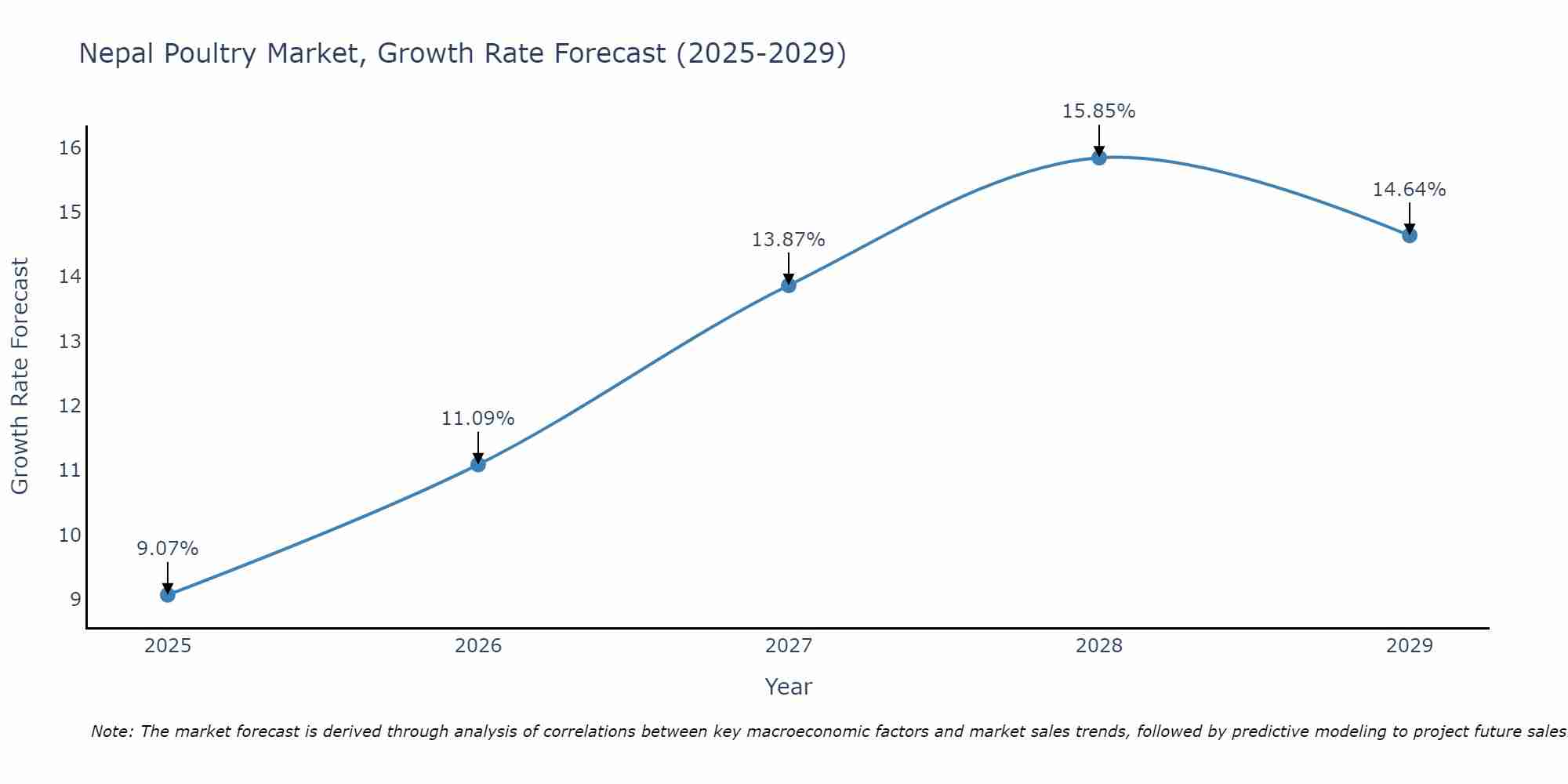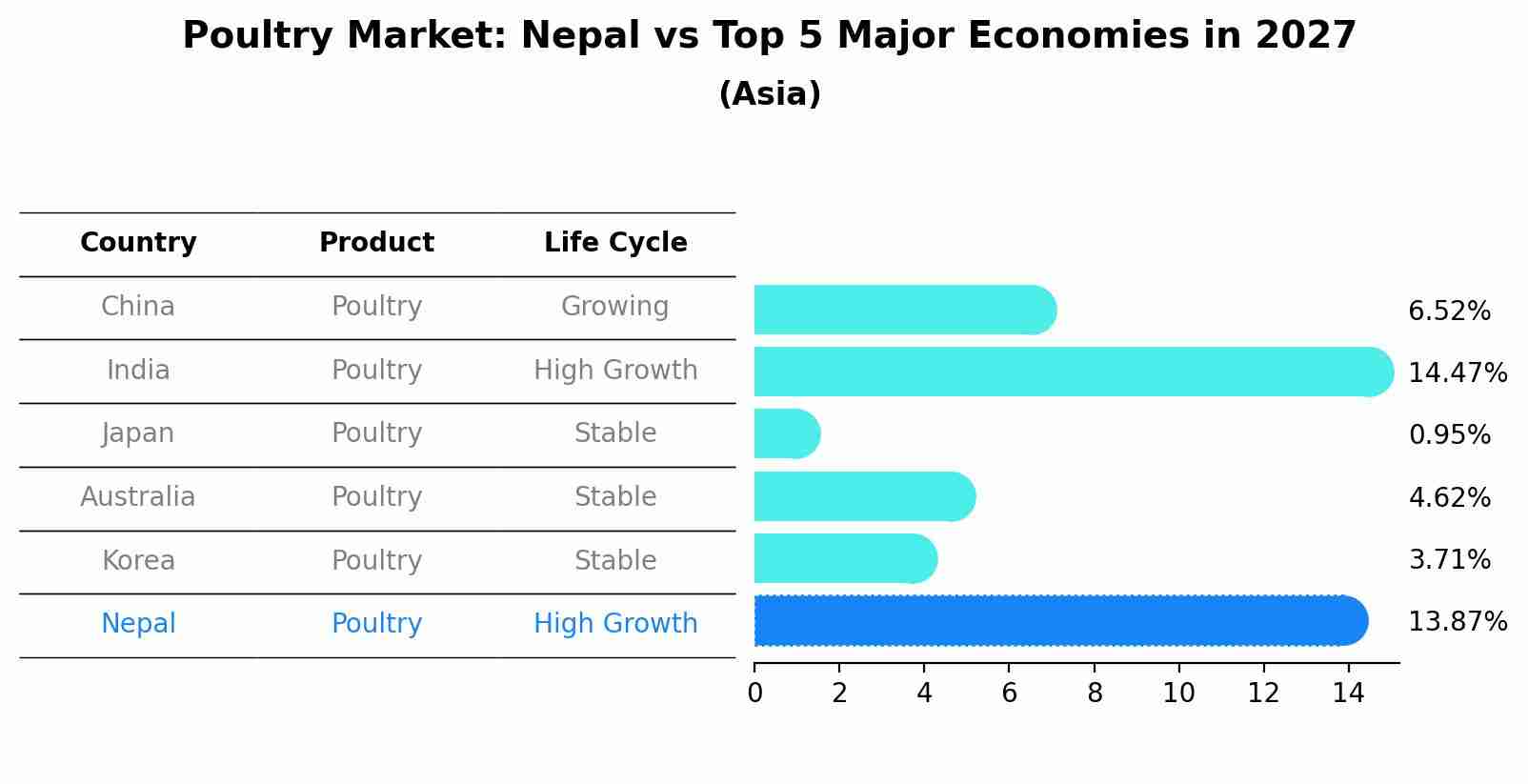Nepal Poultry Market (2025-2031) Outlook | Value, Industry, Size, Analysis, Revenue, Growth, Share, Trends, Forecast & Companies
| Product Code: ETC384216 | Publication Date: Aug 2022 | Updated Date: Jul 2025 | Product Type: Market Research Report | |
| Publisher: 6Wresearch | Author: Shubham Padhi | No. of Pages: 75 | No. of Figures: 35 | No. of Tables: 20 |
Nepal Poultry Market Size Growth Rate
The Nepal Poultry Market is projected to witness mixed growth rate patterns during 2025 to 2029. The growth rate begins at 9.07% in 2025, climbs to a high of 15.85% in 2028, and moderates to 14.64% by 2029.

Poultry Market: Nepal vs Top 5 Major Economies in 2027 (Asia)
In the Asia region, the Poultry market in Nepal is projected to expand at a high growth rate of 13.87% by 2027. The largest economy is China, followed by India, Japan, Australia and South Korea.

Nepal Poultry Market Synopsis
The Nepal poultry market is experiencing steady growth driven by rising demand for poultry products such as chicken meat and eggs. Factors contributing to this growth include increasing population, changing consumer preferences towards protein-rich diets, and the rise of quick-service restaurants. The market is characterized by a mix of small-scale traditional poultry farms and large commercial operations. Key players in the industry include Surya Nepal Private Limited, Chaudhary Group, and Everest Meat Products Pvt. Ltd. Challenges facing the market include disease outbreaks, lack of proper infrastructure, and inconsistent supply chain management. The government plays a crucial role in regulating the industry through policies and guidelines to ensure food safety and quality standards are met. Overall, the Nepal poultry market presents opportunities for further expansion and modernization to meet the growing demand for poultry products.
Nepal Poultry Market Trends
The Nepal poultry market is experiencing several key trends. Firstly, there is a growing demand for poultry products driven by an increasing population and rising incomes. Consumers are seeking affordable and high-quality protein sources, making poultry a popular choice. Additionally, there is a shift towards more sustainable and organic poultry farming practices, as consumers are becoming more conscious of food safety and environmental impact. The market is also seeing an increase in the adoption of technology and automation in poultry farming to improve efficiency and productivity. Overall, the Nepal poultry market is poised for growth with opportunities for innovation and meeting the evolving consumer preferences.
Nepal Poultry Market Challenges
In the Nepal Poultry Market, several challenges are faced, including disease outbreaks leading to high mortality rates among poultry, inadequate biosecurity measures, fluctuating feed prices affecting profitability, limited access to quality veterinary services and vaccines, and intense competition among poultry producers. Additionally, infrastructure issues such as inadequate storage facilities and transportation constraints impact the distribution of poultry products. Furthermore, regulatory challenges and compliance with standards pose hurdles for market participants. These challenges collectively hinder the growth and sustainability of the Nepal Poultry Market, necessitating interventions in the form of improved disease management strategies, enhanced biosecurity protocols, stable feed supply chains, and better regulatory frameworks to support the industry`s development and ensure food security for the population.
Nepal Poultry Market Investment Opportunities
Investment opportunities in the Nepal poultry market are promising due to a growing demand for poultry products driven by population growth and increasing consumer preference for protein-rich foods. Potential areas for investment include setting up modern poultry farms equipped with advanced technology to improve productivity and efficiency, investing in poultry feed production to ensure high-quality nutrition for birds, and establishing processing facilities to meet the rising demand for processed poultry products. Additionally, there is potential for vertical integration within the supply chain to capture value at different stages of production. With a supportive regulatory environment and increasing awareness about the benefits of poultry consumption, investing in the Nepal poultry market presents opportunities for growth and profitability.
Jordan Agar Market Government Policies
The Nepal government has implemented various policies to regulate and promote the poultry market in the country. These policies include the establishment of quality standards for poultry products, monitoring and control of poultry diseases, promotion of biosecurity measures in poultry farms, and support for small-scale poultry farmers through subsidies and training programs. Additionally, the government has introduced initiatives to boost local poultry production, reduce imports, and ensure food safety standards are met. The aim is to enhance the competitiveness of the domestic poultry industry, improve the livelihoods of poultry farmers, and ensure a sustainable and healthy supply of poultry products for consumers in Nepal.
Nepal Poultry Market Future Outlook
The future outlook for the Nepal poultry market appears promising, with a projected growth trajectory driven by factors such as increasing urbanization, rising disposable incomes, and changing dietary preferences towards protein-rich foods. The demand for poultry products, including chicken and eggs, is expected to continue to rise as a result of population growth and a shift towards healthier eating habits. Additionally, advancements in technology and farming practices are likely to enhance productivity and efficiency in the poultry sector, leading to increased supply to meet the growing demand. However, challenges such as disease outbreaks, feed costs, and regulatory issues may pose constraints on the market`s growth. Overall, the Nepal poultry market is anticipated to expand steadily in the coming years, offering opportunities for market players to capitalize on the evolving consumer needs and preferences.
Key Highlights of the Report:
- Nepal Poultry Market Outlook
- Market Size of Nepal Poultry Market, 2024
- Forecast of Nepal Poultry Market, 2031
- Historical Data and Forecast of Nepal Poultry Revenues & Volume for the Period 2021 - 2031
- Nepal Poultry Market Trend Evolution
- Nepal Poultry Market Drivers and Challenges
- Nepal Poultry Price Trends
- Nepal Poultry Porter's Five Forces
- Nepal Poultry Industry Life Cycle
- Historical Data and Forecast of Nepal Poultry Market Revenues & Volume By Segments for the Period 2021 - 2031
- Historical Data and Forecast of Nepal Poultry Market Revenues & Volume By Broiler for the Period 2021 - 2031
- Historical Data and Forecast of Nepal Poultry Market Revenues & Volume By Eggs for the Period 2021 - 2031
- Historical Data and Forecast of Nepal Poultry Market Revenues & Volume By End Uses for the Period 2021 - 2031
- Historical Data and Forecast of Nepal Poultry Market Revenues & Volume By Food Service for the Period 2021 - 2031
- Historical Data and Forecast of Nepal Poultry Market Revenues & Volume By Household for the Period 2021 - 2031
- Historical Data and Forecast of Nepal Poultry Market Revenues & Volume By Distribution Channels for the Period 2021 - 2031
- Historical Data and Forecast of Nepal Poultry Market Revenues & Volume By Traditional Retail Stores for the Period 2021 - 2031
- Historical Data and Forecast of Nepal Poultry Market Revenues & Volume By Business To Business for the Period 2021 - 2031
- Historical Data and Forecast of Nepal Poultry Market Revenues & Volume By Modern Retail Stores for the Period 2021 - 2031
- Nepal Poultry Import Export Trade Statistics
- Market Opportunity Assessment By Segments
- Market Opportunity Assessment By End Uses
- Market Opportunity Assessment By Distribution Channels
- Nepal Poultry Top Companies Market Share
- Nepal Poultry Competitive Benchmarking By Technical and Operational Parameters
- Nepal Poultry Company Profiles
- Nepal Poultry Key Strategic Recommendations
Frequently Asked Questions About the Market Study (FAQs):
- Single User License$ 1,995
- Department License$ 2,400
- Site License$ 3,120
- Global License$ 3,795
Search
Related Reports
- ASEAN Bearings Market (2025-2031) | Strategy, Consumer Insights, Analysis, Investment Trends, Opportunities, Growth, Size, Share, Industry, Revenue, Segments, Value, Segmentation, Supply, Forecast, Restraints, Outlook, Competition, Drivers, Trends, Demand, Pricing Analysis, Competitive, Strategic Insights, Companies, Challenges
- Europe Flooring Market (2025-2031) | Outlook, Share, Industry, Trends, Forecast, Companies, Revenue, Size, Analysis, Growth & Value
- Saudi Arabia Manlift Market (2025-2031) | Outlook, Size, Growth, Trends, Companies, Industry, Revenue, Value, Share, Forecast & Analysis
- Uganda Excavator, Crane, and Wheel Loaders Market (2025-2031) | Strategy, Consumer Insights, Analysis, Investment Trends, Opportunities, Growth, Size, Share, Industry, Revenue, Segments, Value, Segmentation, Supply, Forecast, Restraints, Outlook, Competition, Drivers, Trends, Demand, Pricing Analysis, Competitive, Strategic Insights, Companies, Challenges
- Rwanda Excavator, Crane, and Wheel Loaders Market (2025-2031) | Strategy, Consumer Insights, Analysis, Investment Trends, Opportunities, Growth, Size, Share, Industry, Revenue, Segments, Value, Segmentation, Supply, Forecast, Restraints, Outlook, Competition, Drivers, Trends, Demand, Pricing Analysis, Competitive, Strategic Insights, Companies, Challenges
- Kenya Excavator, Crane, and Wheel Loaders Market (2025-2031) | Strategy, Consumer Insights, Analysis, Investment Trends, Opportunities, Growth, Size, Share, Industry, Revenue, Segments, Value, Segmentation, Supply, Forecast, Restraints, Outlook, Competition, Drivers, Trends, Demand, Pricing Analysis, Competitive, Strategic Insights, Companies, Challenges
- Angola Excavator, Crane, and Wheel Loaders Market (2025-2031) | Strategy, Consumer Insights, Analysis, Investment Trends, Opportunities, Growth, Size, Share, Industry, Revenue, Segments, Value, Segmentation, Supply, Forecast, Restraints, Outlook, Competition, Drivers, Trends, Demand, Pricing Analysis, Competitive, Strategic Insights, Companies, Challenges
- Israel Intelligent Transport System Market (2025-2031) | Strategy, Consumer Insights, Analysis, Investment Trends, Opportunities, Growth, Size, Share, Industry, Revenue, Segments, Value, Segmentation, Supply, Forecast, Restraints, Outlook, Competition, Drivers, Trends, Demand, Pricing Analysis, Competitive, Strategic Insights, Companies, Challenges
- Uganda Precast and Aggregate Market (2025-2031) | Strategy, Consumer Insights, Analysis, Investment Trends, Opportunities, Growth, Size, Share, Industry, Revenue, Segments, Value, Segmentation, Supply, Forecast, Restraints, Outlook, Competition, Drivers, Trends, Demand, Pricing Analysis, Competitive, Strategic Insights, Companies, Challenges
- Australia IT Asset Disposal Market (2025-2031) | Strategy, Consumer Insights, Analysis, Investment Trends, Opportunities, Growth, Size, Share, Industry, Revenue, Segments, Value, Segmentation, Supply, Forecast, Restraints, Outlook, Competition, Drivers, Trends, Demand, Pricing Analysis, Competitive, Strategic Insights, Companies, Challenges
Industry Events and Analyst Meet
Our Clients
Whitepaper
- Middle East & Africa Commercial Security Market Click here to view more.
- Middle East & Africa Fire Safety Systems & Equipment Market Click here to view more.
- GCC Drone Market Click here to view more.
- Middle East Lighting Fixture Market Click here to view more.
- GCC Physical & Perimeter Security Market Click here to view more.
6WResearch In News
- Doha a strategic location for EV manufacturing hub: IPA Qatar
- Demand for luxury TVs surging in the GCC, says Samsung
- Empowering Growth: The Thriving Journey of Bangladesh’s Cable Industry
- Demand for luxury TVs surging in the GCC, says Samsung
- Video call with a traditional healer? Once unthinkable, it’s now common in South Africa
- Intelligent Buildings To Smooth GCC’s Path To Net Zero













